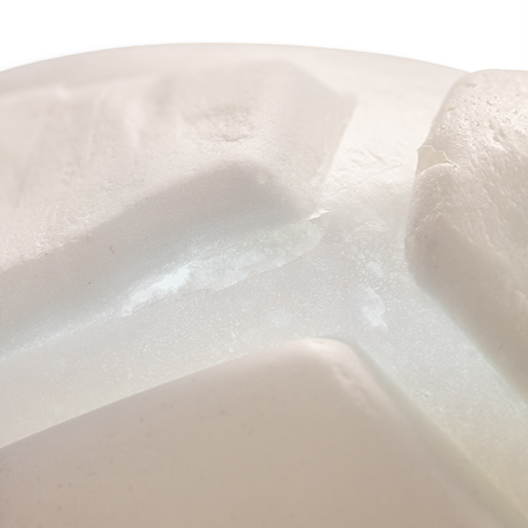
Subsurface voids in polyurethane foam parts
Description:
Air pockets or voids in polyurethane foam parts lead to an impairment of the mechanical strength, density and surface quality.
Affected Foam Parts:
Polyurethane foam parts made of flexible foam, high resilience foam, viscoelastic foam, acoustic foam, insulation foam and back foam are affected.
What causes it:
Air pockets can have various causes. These include insufficient venting of the mould, incorrect pouring patterns or shot quantities, the reaction speed of the polyurethane foam, mixing in the machine head and the flow behaviour of the polyurethane foam.
- Bad venting of mould (vents are plugged or at wrong position, vents are too small, wrong inclination of mould)
- Improper polyurethane pour pattern
- Improper shot weight
- Fast reaction / fast viscosity increase of polyurethane foam (caused by foam formulation / catalyst content, too high mould temperature, or interaction with mould release agent)
- Bad mixing in machine head / very turbulent flow of polyurethane foam
Solutions:
First, the vents and the angle of inclination of the mould should be checked and adjusted if necessary. Using a different polyurethane formulation with an optimized additive content can also help. In addition, cleaning the mixing head and checking the mixing ratios are crucial to ensure a uniform foam composition. Increasing the shot weight can also help to improve mould filling. Another option is to optimize the pour pattern to ensure uniform foam distribution.
- Check whether vents are open and adjust the mould angle/tilt
- Test different type of Release Agent
- Clean and check the mixing head and ratios
- Increase shot weight
- Improve pour pattern
RELATED CASE STUDIES
Chem‑Trend is the global expert in mold release agents, purging compounds, and paper impregnation chemicals, delivering innovative solutions that improve efficiency, reduce waste, and enhance manufacturing performance across diverse industries worldwide.
© 2025 Chem‑Trend L.P. or Chem‑Trend affiliated company. All rights reserved.
Regional websites:
-
Argentina
-
Brasil
(Brazil) -
Canada
-
Česko
(Czech Republic) -
CIS (excluding Russia)
-
Deutschland
(Germany) -
España
(Spain) -
France
-
India
-
Italia
(Italy) -
México
-
România
(Romania) -
Polska
(Poland) -
Türkiye
(Turkey) -
United Kingdom
-
United States
-
Việt Nam
(Vietnam) -
中国
(China) -
한국
(South Korea) -
日本
(Japan)
Notice
You are about to exit this page. You will be redirected to the Chem‑Trend Global website where you’ll find your requested content in English.
Continue